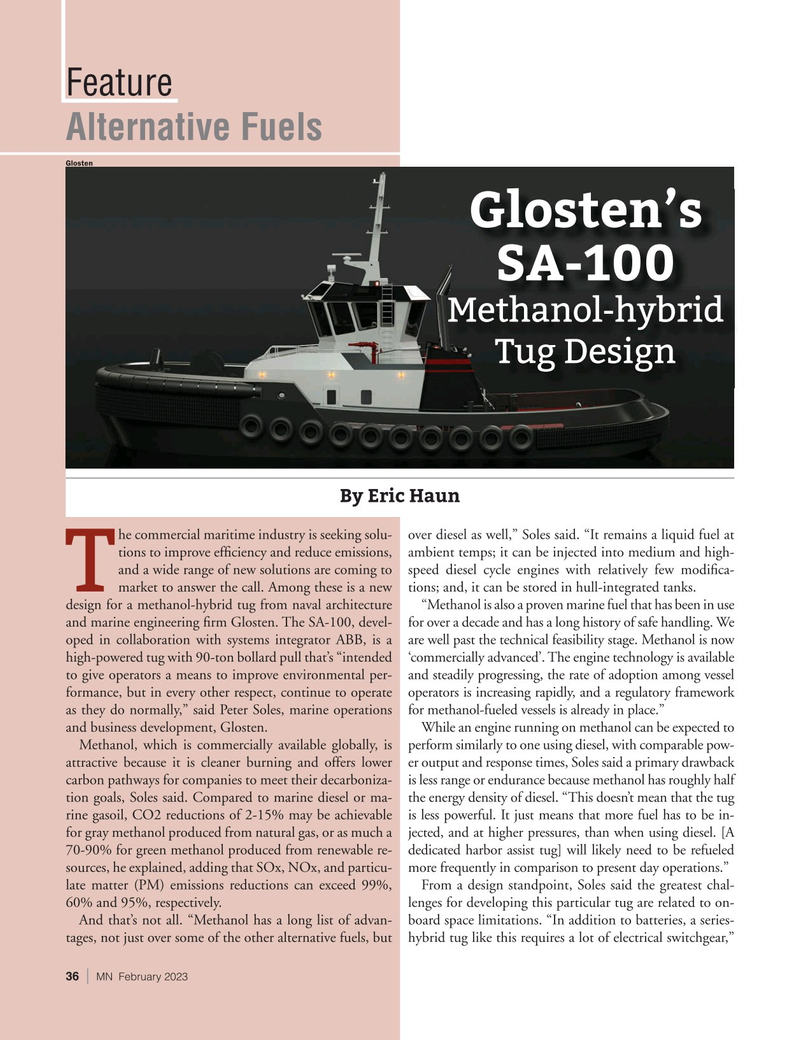
Page 36: of Marine News Magazine (February 2023)
Power & Propulsion
Read this page in Pdf, Flash or Html5 edition of February 2023 Marine News Magazine
Feature
Alternative Fuels
Glosten
Glosten’s
SA-100
Methanol-hybrid
Tug Design
By Eric Haun he commercial maritime industry is seeking solu- over diesel as well,” Soles said. “It remains a liquid fuel at tions to improve ef? ciency and reduce emissions, ambient temps; it can be injected into medium and high- and a wide range of new solutions are coming to speed diesel cycle engines with relatively few modi? ca-
T market to answer the call. Among these is a new tions; and, it can be stored in hull-integrated tanks.
design for a methanol-hybrid tug from naval architecture “Methanol is also a proven marine fuel that has been in use and marine engineering ? rm Glosten. The SA-100, devel- for over a decade and has a long history of safe handling. We oped in collaboration with systems integrator ABB, is a are well past the technical feasibility stage. Methanol is now high-powered tug with 90-ton bollard pull that’s “intended ‘commercially advanced’. The engine technology is available to give operators a means to improve environmental per- and steadily progressing, the rate of adoption among vessel formance, but in every other respect, continue to operate operators is increasing rapidly, and a regulatory framework as they do normally,” said Peter Soles, marine operations for methanol-fueled vessels is already in place.” and business development, Glosten. While an engine running on methanol can be expected to
Methanol, which is commercially available globally, is perform similarly to one using diesel, with comparable pow- attractive because it is cleaner burning and offers lower er output and response times, Soles said a primary drawback carbon pathways for companies to meet their decarboniza- is less range or endurance because methanol has roughly half tion goals, Soles said. Compared to marine diesel or ma- the energy density of diesel. “This doesn’t mean that the tug rine gasoil, CO2 reductions of 2-15% may be achievable is less powerful. It just means that more fuel has to be in- for gray methanol produced from natural gas, or as much a jected, and at higher pressures, than when using diesel. [A 70-90% for green methanol produced from renewable re- dedicated harbor assist tug] will likely need to be refueled sources, he explained, adding that SOx, NOx, and particu- more frequently in comparison to present day operations.” late matter (PM) emissions reductions can exceed 99%, From a design standpoint, Soles said the greatest chal- 60% and 95%, respectively. lenges for developing this particular tug are related to on-
And that’s not all. “Methanol has a long list of advan- board space limitations. “In addition to batteries, a series- tages, not just over some of the other alternative fuels, but hybrid tug like this requires a lot of electrical switchgear,” 36 | MN February 2023

 35
35

 37
37
